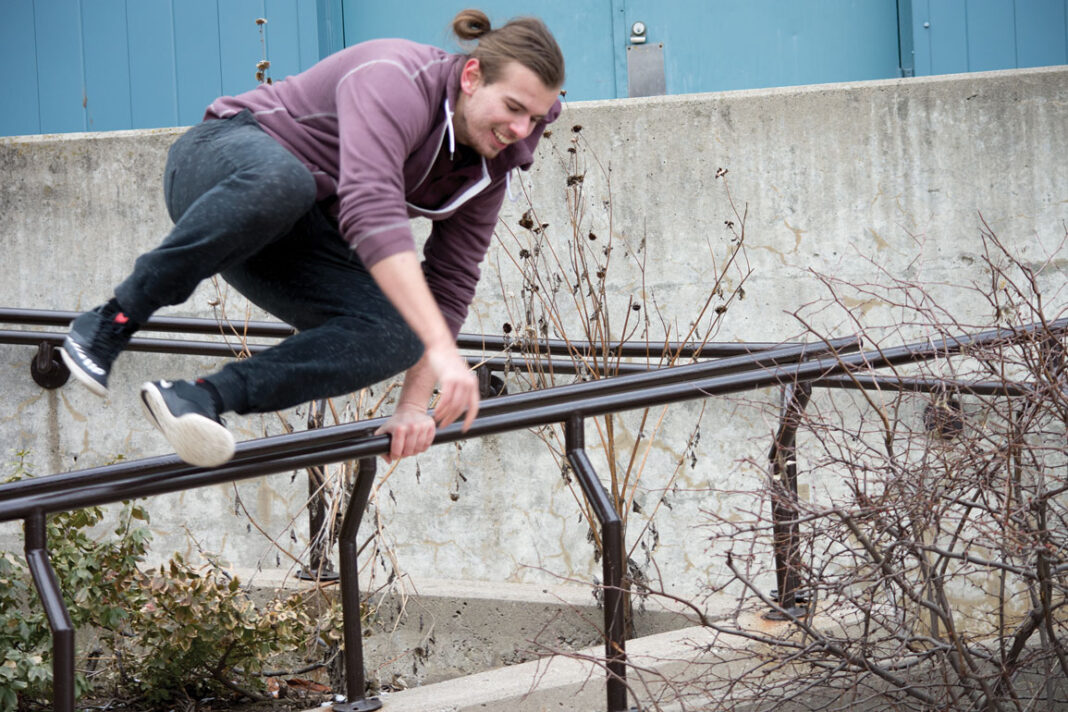BY JEFFERSON MARSHALL
Freedom can be simple. It’s walking up to the edge of the rail and staring down the barrel of your next trick and knowing the only pre-requisite for freedom is a running start and the ingenuity to create. You aren’t going to catch free runners spending their Sunday’s on the couch unless they are vaulting over it.
In fact, they can be found at the local rec centre, running, hopping and vaulting up and down the and concrete ledges. Some of the stunts being pulled off would even make Jean-Claude Van Damme proud.
For GTA parkour member Omari Elemanawi he says parkour was a passion of his before he even knew it.
“When I was a kid I always used to climb walls and trees. There were mountains around my area, so I would always find myself going mountaineering,” says Elemanawi.
“So I was always jumping things, and it was just natural to me,” he says.
Parkour is essentially moving creatively through an area. Running, jumping, climbing, and vaulting are the fundamental skills. Usually urban atmospheres are an ideal location because of all the different buildings, walls, ledges, and railings that free runners can use as obstacles.
In most sports, there is an opponent that you spend the entire game trying to beat, or there’s a star player that needs to be in the middle of every play to maximize their team’s chance of winning. In parkour there isn’t any of that. Everybody is there to improve themselves and the people around them with no opposition on the other side.
The documented origins of this sport dates back to the first World War when French naval officer, Georges Hébert, admired the athleticism of the native tribes he met in Africa. A Swiss architect was so inspired by Hébert’s work that he developed an obstacle course where soldier’s physical capabilities could be tested which is now the globally standard procedure for military training.
Fast forward about 30 years later when David Belle was born. Son of French army veteran Raymond Belle, David was exposed to the way army personnel were trained at a very young age. After completing his military service David would continue his parkour training and would film his sessions which he would later turn into a news feature about parkour. The video gained traction and made people aware of the sport. Today David is known as the godfather of parkour.
In 2010 Greater Toronto Parkour started as a non-profit organization that is dedicated to promoting mindful parkour, freerunning and L’Art Du Deplacement around the city.
“It started off with the website meetup.com where people would organize sessions and meet together and over the years of building up it was officially turned into a non-profit organization with the goal of promoting safe and mindful parkour practice in and around Toronto,” says Greater Toronto Parkour board member Iliya Begic, 24, who is also is attending York University for anthropology.
Now with almost 200 members on their Facebook page the GTA parkour are a vast group from the Philippines to Scarborough but welcome newcomers with varying levels of skills
Despite diversity it’s easy to see that the parkour community has a tight-knit culture and no matter what skill level that is brought to the table there will never be a time when someone will feel like an outlier.
“Everyone I meet is very different but it’s good because we get together and learn from each other,” says Begic.
“So, either with movement or technique there’s always something you can learn. You can talk to people to form these great relationships. I think it’s one of the biggest drawing factors for parkour. It’s not even the sport itself, it’s the community it creates.”
For one member of the GTA parkour group the sport means a little more than just a social atmosphere. Chantelle Flores moved to Canada from the Philippines three years ago, and has found solace in parkour.
“Parkour helps me with my self-esteem because in the Philippines your height even effects your job opportunities.” says the 30-year-old Philippine native.
The 4’9” Flores says she was unable to be a cashier in her home country due to the height requirement which is 5’0” for that position. In contrast, the average female in Canada is 5’4”. In the Philippines the average female is 4’11”. Despite being one of the smaller countries in the world, it still doesn’t change these height regulations.
“It was tough for me, because I know I’m capable but I can’t help it because it’s the culture. So, when I came here [Canada] I tried parkour and when I hurdle over the obstacles it makes me feel capable,” says Flores.
“The relationships I’ve made here are something more distinctive I know my group members on a different level because I’ve seen them face fears,” says GTA parkour member Smiley Jammer.
“There’s really a strong emphasis on individual choice and if I were to push someone and say ‘oh come on you should do it’ and then they fall and hurt themselves then that’s really on me. So we don’t do that and we really respect each other and our choices and that’s really something beautiful about the relationships I’ve built here,” says Jammer.
The parkour collective is unique and growing. The UK has become the first country to recognize parkour as an official sport as of this past January. Sport or not parkour brings people together on an expansive playing field where nobody wants to see anybody fail.

